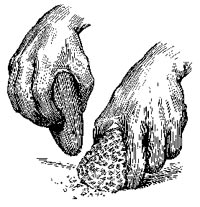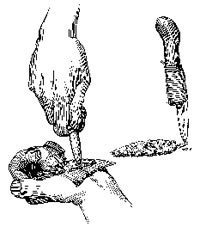Hickory Bluff Project

Come Explore Your Heritage. Dive Into The Past
Issue 5a: Stone Tools?
For most prehistoric Native American groups, stone was the hardest material available for making tools. With very few exceptions, people did not have access to metal. Shell, hard wood, or bone was used for many tools, but the toughest and most durable material around was stone.
At sites like Hickory Bluff, stone tools were generally manufactured in one of two ways: by grinding and pecking the stone to form the desired shape, or by chipping fragments from it. Both techniques could be used to make either crude, quickly formed tools or highly crafted pieces of almost artistic quality.
Pecked or groundstone tools were often made from heavy, dense material like greenstone. Examples of groundstone implements include axes, hammers, or mortars and pestles, tools for which weight is an important quality.




Stone could also be chipped to produce fine cutting edges. Brittle stone, such as chert, quartz or argillite, that breaks in ways similar to glass, were chosen for these tools. Starting with a large rock, like a stream cobble, chips were struck from the piece with another rock at an angle that removed relatively thin, flake-like fragments. These flakes bore sharp edges and could be used immediately as tools for cutting or scraping. Additional flakes were removed to bring the piece to the desired shape. Most artifacts were flaked from alternate sides or faces, and the resulting artifact is termed a biface. As the tool took shape, the thick end of a deer antler was often used for more controlled flaking, to refine the form and sharpness of the cutting edge. Final flaking was usually carried out by pressing tiny flakes from the edge with the pointed end of the antler.








